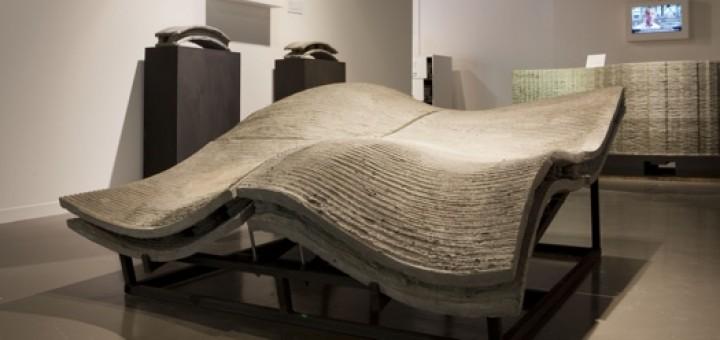 Construction is one of the main areas 3D printing has been projected to impact substantially, all along. It also tends to be the example of choice for critics asking what happened to all those lofty architectural plans that have yet to be seen on the ground. There aren’t 3D printers in every home yet, and few of us are living in 3D printed homes or working in 3D printed office buildings despite some far-out concepts, as well as compelling international models actually coming to fruition. So is this thing really on or what?
Construction is one of the main areas 3D printing has been projected to impact substantially, all along. It also tends to be the example of choice for critics asking what happened to all those lofty architectural plans that have yet to be seen on the ground. There aren’t 3D printers in every home yet, and few of us are living in 3D printed homes or working in 3D printed office buildings despite some far-out concepts, as well as compelling international models actually coming to fruition. So is this thing really on or what?
While other sectors such as automotive, aerospace, and medical are showing huge strides, in the construction arena we’ve seen slower progress, but it’s definitely been there, even if just in baby steps, and much of these have involved building a foundation of impact that begins with the tools and materials. They are definitely emerging, from 3D printers that can make bricks to drones that function as self-sustained mini construction factories. While some of this is still fantastical, the progress is undeniably quite substantial—and we see numerous large delta style 3D printers emerging too for construction, even playing a part in some amazing projects which may just be one-offs so far, but they do also answer the question with a resounding “yes, 3D printing in construction is so on.”
 Materials, of course, are at the crux of this conversation. Perhaps we have the plans and the tools and are ready to erect buildings galore—but with what? Why, concrete, of course. And just how this is and will be done is the major focus of a recent study by Research and Markets as they look at the what, when, and where for concrete 3D printing in 3D Concrete Printing Market By Product Type, by Concrete Type, by Software, by End-Use Sector & by Region – Forecast to 2021.
Materials, of course, are at the crux of this conversation. Perhaps we have the plans and the tools and are ready to erect buildings galore—but with what? Why, concrete, of course. And just how this is and will be done is the major focus of a recent study by Research and Markets as they look at the what, when, and where for concrete 3D printing in 3D Concrete Printing Market By Product Type, by Concrete Type, by Software, by End-Use Sector & by Region – Forecast to 2021.
Research and Markets, a research and analysis company that offers resources to companies and investors around the world, is offering their take on how 3D printing will transform construction with a material that’s undoubtedly familiar to us all.
The question isn’t whether concrete 3D printing will begin to play a large role in the construction industry, but just when and how much. Due to the benefits offered, one would imagine many in the business are scrambling to know more and figure out how they can take advantage of the new technology as it offers major savings on the bottom line, greater speed and accuracy, and will be attractive to consumers looking to buy more affordable real estate in the future.
The study focused on what the future market size is for this technology and materials in construction, along with the true potential for growth as they examined the following:
- Product type
- Concrete type
- Software
- End-use
- Regions
The time period they examined, from 2015-2021, allows for a look at how construction will propel the growth of 3D printing, beginning with studying vendors and their revenues.
“The bottom-up procedure was employed to arrive at the overall size of the global 3D concrete printing market from the revenue of the key players,” states Research and Markets.
They assessed market size and then moved on to dividing it into different segments and subsegments, further studied and verified with numerous, comprehensive interviews with the higher-ups in many companies, to include CEOs and executives.
“These data triangulation and market breakdown procedures were employed to complete the overall market engineering process and arrive at the exact statistics for all segments and subsegments,” states the Research and Markets team.
Following are some of the 3D concrete printer manufacturers, architects, contractors, and vendors they see making up the ecosystem:
- DUS Architects (The Netherlands)
- Skanska (Sweden)
- Fosters + Partners (U.K.)
- WinSun Global (China)
- Sika (Europe)
- LafargeHolcim (Europe)
- Balfour Beatty (U.K.)
- Carilliom Plc (U.K.)
The study shows that many construction companies are and will be using concrete 3D printing, and that it has also been growing in direct accordance with the industry overall, around the world. As industrialization increases, along with further urbanization, this leads to expanded building of a wide range of structures around the world.
The research divides the 3D concrete printing market into the following submarkets:
Product Type:
- Walls
- Floors and roofs
- Panels and lintels
- Others (staircases and paving slabs)
By concrete type:
- Ready-mix concrete
- Precast concrete
- Shotcrete
- High-density concrete
- Others (lightweight concrete, limecrete, and stamped concrete)
By Software:
- Design
- Inspection
- Printing
By End-Use Sector:
- Architectural construction
- Industrial construction
- Domestic construction
- Residential
- Commercial
- Others (sports, education, and healthcare)
By Region:
- North America
- Europe
- Asia-Pacific
- RoW (UAE and other countries in RoW)
The Research and Markets team believes that as the global economy continues to recover, further demand can be expected for 3D printing and specifically that with concrete, leading to a market projected to be worth $56.4 million by 2021.
Leading the pack will be Asia Pacific. The research company sees this region as growing the fastest, offering the biggest demand, and being open to the use of the technology and materials. High incomes with disposable cash will obviously propel 3D printing with concrete in construction along. Not surprisingly, China is expected to be the fastest growing country for the use of 3D printing with concrete from a global perspective, with all the elements in place: government interest and encouragement, standardization efforts, growing need, developing technologies, and, of course, an awareness of the new tools, materials and all the benefits that can be found in using them.
Obvious obstacles to be considered are that of the amount of investment capital this technology can require—not to mention research and development—along with understanding how to use the hardware and put automation techniques into motion.
The study was meant to answer questions for stakeholders and potential investors, allowing them to understand which markets should be focused on for ‘prioritizing efforts and investments.’ The target audience for the reports includes raw materials suppliers, 3D concrete printing manufacturers, equipment manufacturers, real-estate agents, consulting firms, and more. For more information on this study, see Research and Markets. Discuss further in the 3D Concrete Printing Industry forum over at 3DPB.com.
Subscribe to Our Email Newsletter
Stay up-to-date on all the latest news from the 3D printing industry and receive information and offers from third party vendors.
You May Also Like
3D Printing News Briefs, April 27, 2024: Research, Digital Dentistry, Cycling, & More
We’re starting today’s 3D Printing News Briefs with some research into 3D printed luminescent quantum-dot polymer architectures and free-form laser beam shaping, and then on to an open source 4-axis...
HP & INDO-MIM Collaborate to Boost Metal 3D Printing in India
HP Inc. and INDO-MIM, a US- and India-based supplier of metal injection molding (MIM) powders and contract manufacturer, have announced that the two companies will collaborate to accelerate additive manufacturing...
3D Printing News Briefs, February 17, 2024: Shot Blasting, Service Bureaus, & More
In today’s 3D Printing News Briefs, we’re starting out with post-processing, as SKZ Würzburg is using a shot blast system from AM Solutions for its research. Moving on to business,...
3D Printing News Unpeeled: Not That Kind of Organ 3D Printing
GKN Aerospace will create a 150 jobs in Trollhattan Sweden with an investment of $60 million part of which comes from the Swedish Energy Agency’s Industriklivet initiative. The investment will...


































